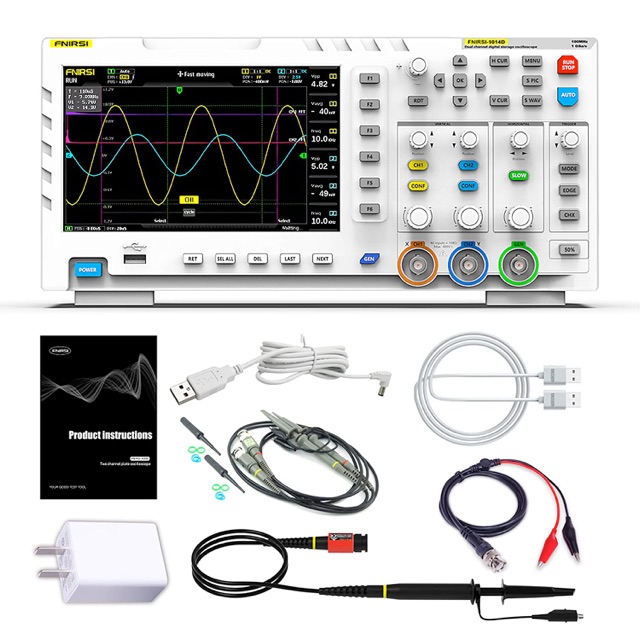FNIRSI 1014D Review
Digital Oscilloscope & Signal Generator

FNIRSI 1014D Review
Digital Oscilloscope & Signal Generator
FNIRSI 1014D Review
Monday, October 31, 2022

I decided to buy a small digital oscilloscope for the workbench and general portable use. While my old Tektronix is “portable”, it’s too big and heavy to fit on the circuit assembly bench. It stays on the test bench. A look online turned up a number of similar LCD digital oscilloscopes in the $150 to $200 range. This model under several brand names adds a signal generator to the dual trace scope function, and looked like it would be handy. Amazon dropped it at my door the same night.
It’s a basic 2-channel scope with 7 inch color LCD display, rubber chiclet buttons and rotary encoders that change function, displaying and selecting from menus on the screen. If you’ve used a digital scope before, you can figure the menus and user interface out. It’s not like my old analog scope. The manual is not much help, apparently machine translated from Chinese. It is useful mostly as a guide to what functions exist and specifications.
It comes with a surprising set of probes, considering that a single 1X - 10X probe from Tektronix or Fluke casts more than the whole package. There are two 1X - 10X probes with interchangeable tips, a 100X high voltage probe, and a BNC to alligator clips cable for the function generator. The scope runs on 5VDC @ 2A from a USB switching power adapter. The power cable and a USB A to USB A cable for connection to a PC for screen captures are included. A complete package.

Plugged it together and played around to see how it performs. First thing I noticed is a lot of noise spikes on the signals. That turned out to be from the AC adapter. Running it from an Apple 5V 2A USB charger worked much better. A USB battery power bank would be even better, but it will need to supply 2A continuously. A built-in battery would be a nice upgrade for ground isolation and portability.
The next thing I noticed is the vertical amplifiers are limited in sensitivity and response. The input impedance is a standard 1M ohm, but the capacitance is 100 - 300 pF, limiting response on X1 probes to around 1MHz. “100MHz” on X10, which is the listed limit of the “1G Samples/Sec” ADC. The true sample rate is 200K S/S with interpolation over multiple samples and simulated signal displays over 43mHz. Call it a 30MHz ‘scope.
Maximum sensitivity is 50mV / Div, which means the smallest useful signal you can see is about 1/4 volt at low frequencies and 3V over 1mHz. So it’s good for digital signal tracing, +4 line to speaker level audio, 12V automotive, AC and power supply troubleshooting, etc. For most audio troubleshooting and signal tracing a preamp of some sort will be needed. Something like my M-Audio Audio Buddy, a small mixer, or a purpose-built preamp.
Triggering is decent, and there is a 3000 sample memory, so it should be able to capture one-shot glitches. Voltage calibration is off by various amounts depending on settings. A 500mV P/P square wave from a Tektronix signal generator measured 562 mV on one channel and 580mV on the other. Consider the readings as ballpark figures rather than exact.
The signal generator has a number of built-in wave shapes, like sine, square, sawtooth, triangle, exponential, log, etc. It can also use saved signals captured by the scope and play them back at 1Hz - 1MHz with 1Hz increments. All very good, but there is no output level control. None. To be useful, some sort of output cable with attenuator / volume control will be needed.

In summary, it mostly does what is promised. It hasn’t crashed, the menus and functions work as advertised, but you’re pretty much on your own to push buttons and twirl knobs to figure out the user interface. The screen is bright and clear enough.
The manual is small and set in very tiny type. It’s poorly translated, but technical terms are technical terms in any language, so you can figure out specifications and features, which is the main function of a manual.
The USB computer interface gives access to an internal 8GB memory card where screen captures and waveforms are stored.
I think I’ll build a small box to sit under the scope with a clean 5V power supply, a couple of preamplifiers for 1X, 10X, 100X, and maybe 1000X gain, and an attenuator for the signal generator. The preamps can be fairly simple op-amp circuits with AC coupling.
That should make it very handy for my uses. So it’s not a replacement for the Tektronix. If you have an analog scope, hold onto it. Digital scopes can be weird with aliasing and sampling glitches. My Tek 2211 is a hybrid which can be pure analog, or digital storage. It’s an invaluable tool.
FNIRSI’s main fault is claiming more than the hardware actually supports. Common with Chinese gadgets. A 30MHz dual trace scope for under $200 is still a winner.